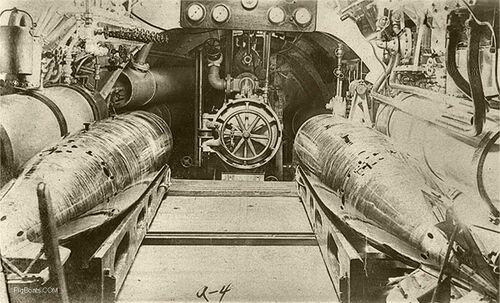A-4: Difference between revisions
Pbcjohnston (talk | contribs) Updated A-4 page |
Pbcjohnston (talk | contribs) Added photos and captions |
||
| Line 1: | Line 1: | ||
[[File:Plunger Header 1.jpg]] | [[File:Plunger Header 1.jpg]] | ||
<div style="text-align: justify;"><span style="color:#00008B"> | [[File:A-4 at New Suffolk.jpg|left|500px]] | ||
<div style="text-align: justify;"><span style="color:#00008B">A newly completed Moccasin (Submarine No. 5) moored at the Holland facility at New Suffolk, NY., approximately 1903. It was quite normal for these boats to sit moored with a stern down angle, especially if there were no torpedoes onboard. The engine, motor, and compressors were all aft, causing this trim downward. | |||
In the background is the incomplete hulk of the Holland submarine Plunger of 1895 (NOT the USS Plunger (Submarine No. 2)). She was built under a Navy contract but was a complete failure and it was never commissioned into the Navy. The boat was also known as the Holland V. Her hulk was retained by the builder until 1917 when she was finally scrapped. | |||
<small>U.S. Navy photo</small> | |||
[[File:Red bar sub.jpg]] | |||
[[File:A-4 torp room.jpg|left|500px]] | |||
The interior of the USS Moccasin showing her torpedo tube and two reload torpedoes. The photo was taken at Cavite, Philippine Islands, circa 1912. What look to be torpedoes outboard on each side are actually air flasks. The torpedoes are resting on wood "skids", called that because they were "skidded" on the thwart ship rails seen running from side to side in the photo, to align it with the tube for loading the torpedo. | |||
The weapons shown here are Whitehead Mark 3 torpedoes. They were 11.6 feet long and 17.7 inches wide to fit into the tubes of the A-class submarines. They carried a warhead with 118 pounds of wet gun-cotten and had a range of 800 yards at 27.5 knots. | |||
An interesting tidbit is the fan mounted above and to the right of the torpedo tube. Use to provide the crew with some air circulation and cooling. It also prevented the accumulation of hydrogen gas to pocket in one place as the battery out-gassed during charging. | |||
The interior of the A-class boats was one large space with no bulkheads. Where this photo was taken from is approximately the center of the submarine. Below the deck seen in this photo is the ship's storage battery used for electrical power for lighting and propulsion while submerged. The battery is covered by wood planks and then has a canvas covering that is stretched tight and then shellacked in place or may be painted to make it watertight. | |||
<small>U.S. Navy photo</small> | <small>U.S. Navy photo</small> | ||
Revision as of 16:06, 20 October 2023

In the background is the incomplete hulk of the Holland submarine Plunger of 1895 (NOT the USS Plunger (Submarine No. 2)). She was built under a Navy contract but was a complete failure and it was never commissioned into the Navy. The boat was also known as the Holland V. Her hulk was retained by the builder until 1917 when she was finally scrapped.
U.S. Navy photo

The interior of the USS Moccasin showing her torpedo tube and two reload torpedoes. The photo was taken at Cavite, Philippine Islands, circa 1912. What look to be torpedoes outboard on each side are actually air flasks. The torpedoes are resting on wood "skids", called that because they were "skidded" on the thwart ship rails seen running from side to side in the photo, to align it with the tube for loading the torpedo.
The weapons shown here are Whitehead Mark 3 torpedoes. They were 11.6 feet long and 17.7 inches wide to fit into the tubes of the A-class submarines. They carried a warhead with 118 pounds of wet gun-cotten and had a range of 800 yards at 27.5 knots.
An interesting tidbit is the fan mounted above and to the right of the torpedo tube. Use to provide the crew with some air circulation and cooling. It also prevented the accumulation of hydrogen gas to pocket in one place as the battery out-gassed during charging.
The interior of the A-class boats was one large space with no bulkheads. Where this photo was taken from is approximately the center of the submarine. Below the deck seen in this photo is the ship's storage battery used for electrical power for lighting and propulsion while submerged. The battery is covered by wood planks and then has a canvas covering that is stretched tight and then shellacked in place or may be painted to make it watertight.
U.S. Navy photo
Page created by:
Ric Hedman & David Johnston
1999 - 2023 - PigBoats.COM©
Mountlake Terrace, WA, Norfolk, VA
webmaster at pigboats dot com
